ASUS Transformer Pad: netbook is dead, long live netbook!
Back in 2007, at Computex, ASUS presented the first netbook to the people: a seven-case Eee PC with a simple Intel Celeron M processor and a “ridiculous” price of $ 250. For several years, netbooks have been the kings of the market for low-cost devices: various diagonals, built-in 3G modules, volumetric batteries, dozens of options from different vendors ... They were replaced by ultra-compact laptops, Macbook Air became the parent of the forms and capabilities, however, to "netbook" prices and did not fall. In the yard of 2015, high-speed Internet is available to everyone, 3G connection and LTE are on an unlimited basis for reasonable money, and ASUS is trying to repeat the success of netbooks, but on a different platform.

ASUS TF103CG is a hybrid tablet, netbook and just a cool device on the Android OS. Is it possible to fully live with such a set of properties?
I could not decide for a long time how to proceed with the beginning of the article: tell about the device and then try to understand for whom it is, or, conversely, first present a certain audience for it and then understand whether this device is suitable for this audience or not. I decided to take the second path, so let's start by defining the parameters of “fully live”. It would not be a question if you were on a Windows netbook, however, we are dealing with a completely “mobile” Android OS!
')
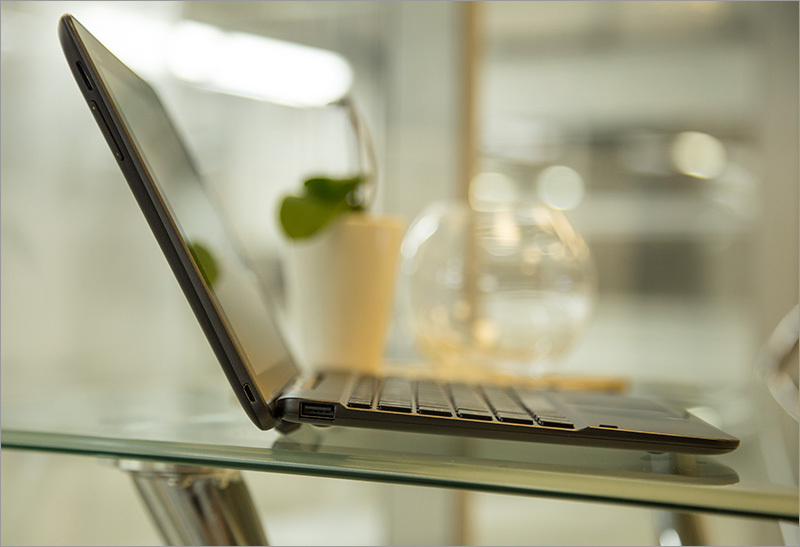
What are people doing on a laptop today, if they needed an inexpensive, long-playing, compact device? First of all, of course, student needs emerge in my head. The university already in 2009, all netbook owners successfully overtook the "manuscripts" in lectures, and the "calculators" in the laboratory. Word and Excel covered 90% of typing requirements and more or less complex calculations. In addition, to prepare for any exam and share lectures much easier when they are stored in digital form. This also includes the constant access to Wikipedia and other online services. A course programmer, of course, will not be easy to write on such a device, and it won't be possible to put all sorts of CAD on Android, but we will solve this question later.
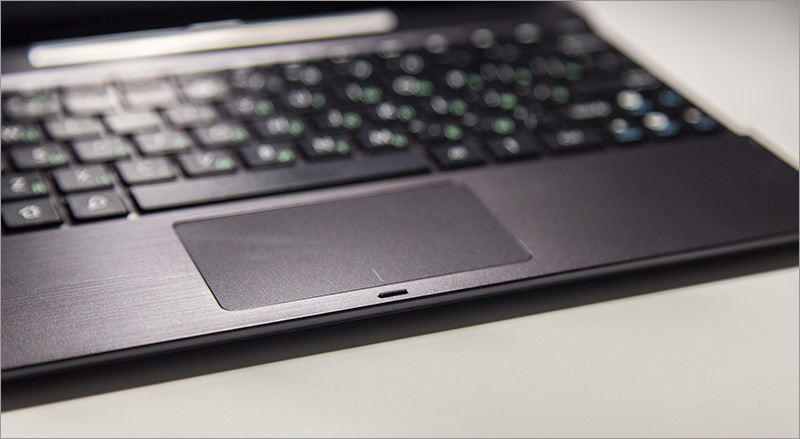
Who else besides students may be interested in such a device? In my opinion, such a laptop may be of interest to those parents whose children met with computers before them. Learn online and social networking, sometimes Skype, receive photos by mail and send them yourself. This also includes receiving news and weather, numerous reminders, a notebook and simple games.
Well and the third audience, by itself, - geeks. Their needs can rarely be called “ordinary” or “popular”, and they will always find what to do with what OS the device doesn’t enter the market.
So, for a normal digital life with such a device you need:
- Be able to edit MS Office documents;
- Have a full access to the Internet;
- Have the ability to sometimes run specialized software: image editors, CAD-systems;
- Have a convenient access to the file system, the ability to send and receive any attachments via the Internet, trite to be able to throw files on a USB flash drive;
Ideally, the device should not generally differ in user experience from the usual desktop OSes, but this is an unattainable ideal. Let's go to the capabilities of the device? :)
The following hardware will solve our problems today:
Processor: X86 compatible, Intel Atom Z2560, 2 cores at 1.6 GHz;
RAM: 1024 MB;
Built-in memory: 16 GB;
Display: 10.1 ", IPS with LED-backlit, resolution - 1280x800 pixels, touch, up to 10 touches;
Wireless interfaces: WiFi b / g / n, Bluetooth 4.0 LE, 2G / 3G cellular networks;
Sensors: GPS, three-axis gyroscope, three-axis accelerometer, light sensor;
Connectors: 3.5 mm MiniJack for connecting a headset, a microSD memory card, microUSB in a screen module, USB in a keyboard, a proprietary dock connector;
Camera: 2 Megapixel main, 0.3 Megapixel front.
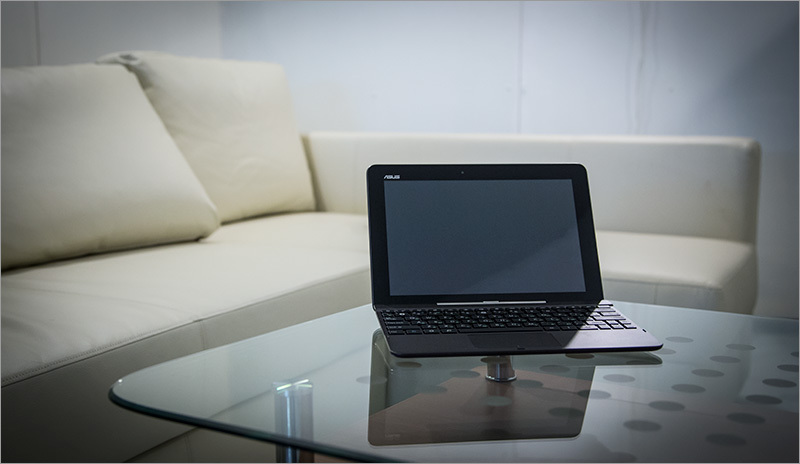
The manufacturer claims the battery capacity of 19 watts * hours and up to 9.5 hours of battery life, weighs all this magnificence in the collection of 550 grams.
As you can see, the hardware device did not go far from its ideological parents, except that modern technologies allowed the device to significantly "squeeze", and to work longer with about the same loads.
The box is made in the standard “Asusov” style, and looks more like a notebook than a tablet, but the package bundle is mobile.
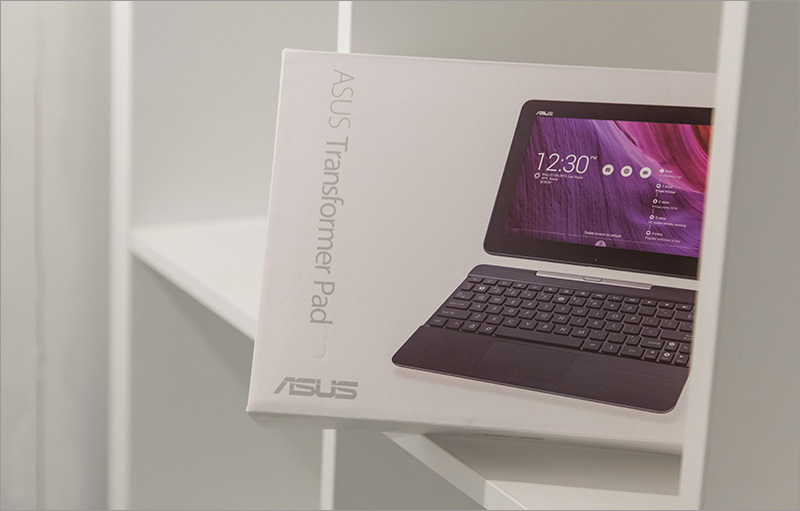
Inside there is only the device itself, the adapter in the outlet (with a USB-mom) and a USB-cord (all kinds of papers do not count). No headphones, no bag, no cover, no cloth to wipe the screen. :(

It is already good that the device is charging through the most standard and ordinary microUSB, which is on every corner - you can not carry the charge with you.
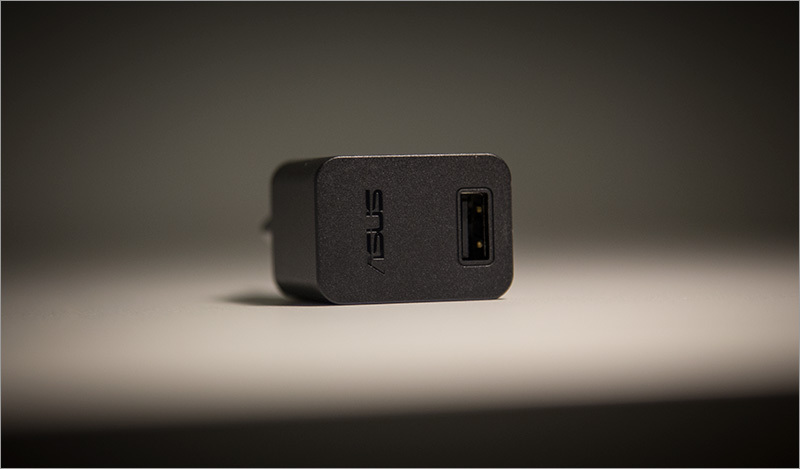
On the other hand, from any telephone semi-amp network memory can be recharged all night: the native power supply produces 1.35 A.
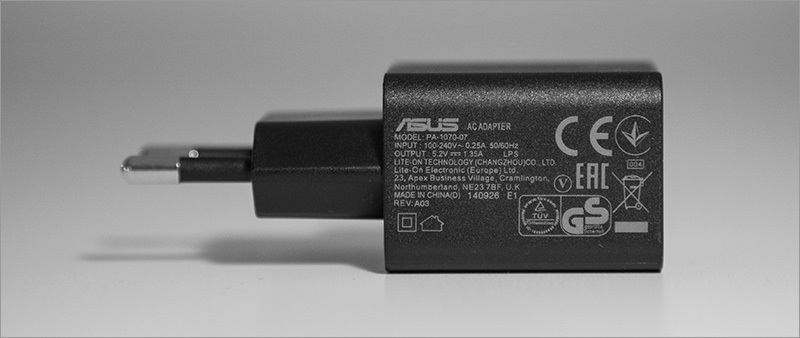
Oh yes. There is also such a thing to extract the sim-tray.

The first thing you need to understand when communicating with this device is that this is an Android tablet with a keyboard, and not a laptop with a detachable display. Therefore, it is not entirely clear why the device is called a “transformer” - there are no transformation options as such, unlike the same yoga ; otherwise, with the same success, the transformer can be called any other tablet, to which you can buy an accessory in the form of a keyboard.

The tablet is made of plastic, the coating is somewhat like a soft-touch, but it is much less “rubber” - just a high-quality matte coating.
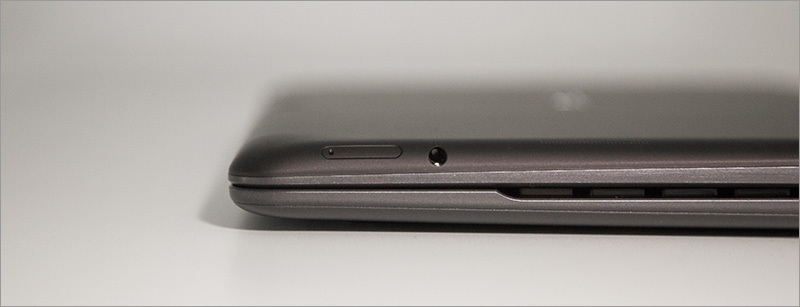
My copy was of a brown tint; light gray versions are also on sale. By itself, the body is not very easily soiled: it does not collect dirt, dust does not stick to it, but after the fried chicken the hands should be well washed - fat fingerprints remain, but it is not easy to scrub them.

I remember well how ASUS in each model of the netbook made frames around the displays, however, this time it carried by - apparently, only due to the fact that the touch screen is used. It is covered with a glossy protective glass with oleophobic coating, supports multitouch.

The resolution, of course, is not the flagship name (1280x800), but in work for many tasks it will be quite enough. Unsatisfied users will not see the difference, but I can advise those who are used to retinas and other HiPDI devices only to look at the price of the device: 16,490 ever-tree rubles (at the time of writing this article). The sensitivity of the sensor is good, the brightness margin is sufficient, it is regulated within very wide limits.

The keyboard module contains 81 buttons, a USB port for connecting external devices, a touchpad, and a proprietary connector to work with the tablet, and (probably) a cast-iron plate, otherwise the weight cannot be explained. :) Material - matte plastic with brushed aluminum texture, pleasant to the touch, but does not give a drop of iron chill.
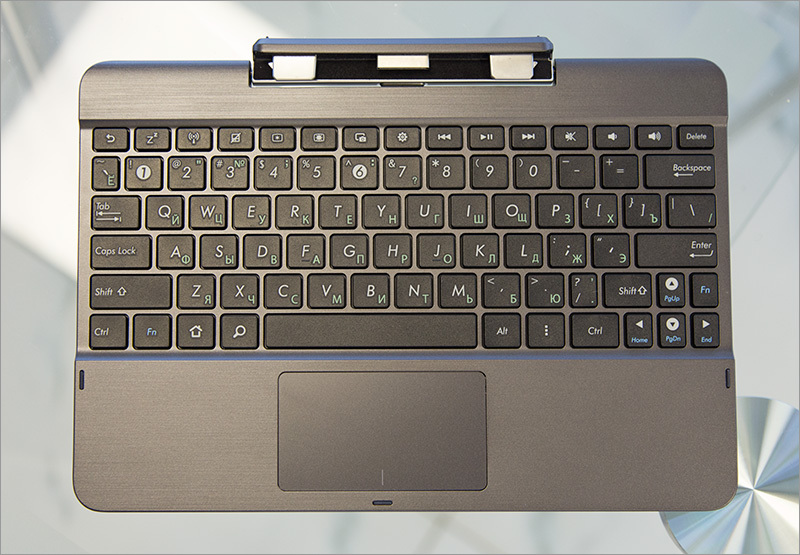
Keystroke, their size is typically netbook, since 2008-2009 nothing has changed. Well, except that there is no F1-F12, as they are not needed in Android OS. Instead, the buttons for adjusting the brightness, volume, taking screenshots, and all that for which you would have to remove your hands from the keyboard. In general, not a MacBook, of course, but you can use it.

The keys have no backlighting, although with such a simple device, the dock might well have collapsed on the LEDs, there are no tricky electronics, there shouldn't have been any problems with installing the backlight.
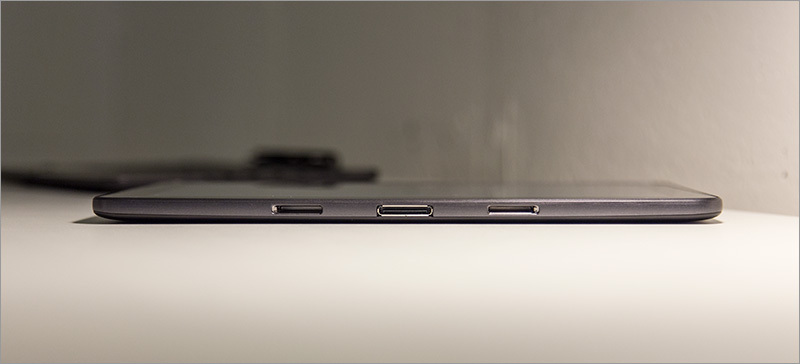
The touchpad can be used, the cursor moves normally, to get to the letter-letter distance is not a problem, but in most cases it is easier to poke into the screen. The touchpad sound is quite loud, the button stroke is tight, but you can get used to it.

Transformation from one state to another is easier than ever: squeezed the “clutch pedal”, and tore off the screen. Like that:
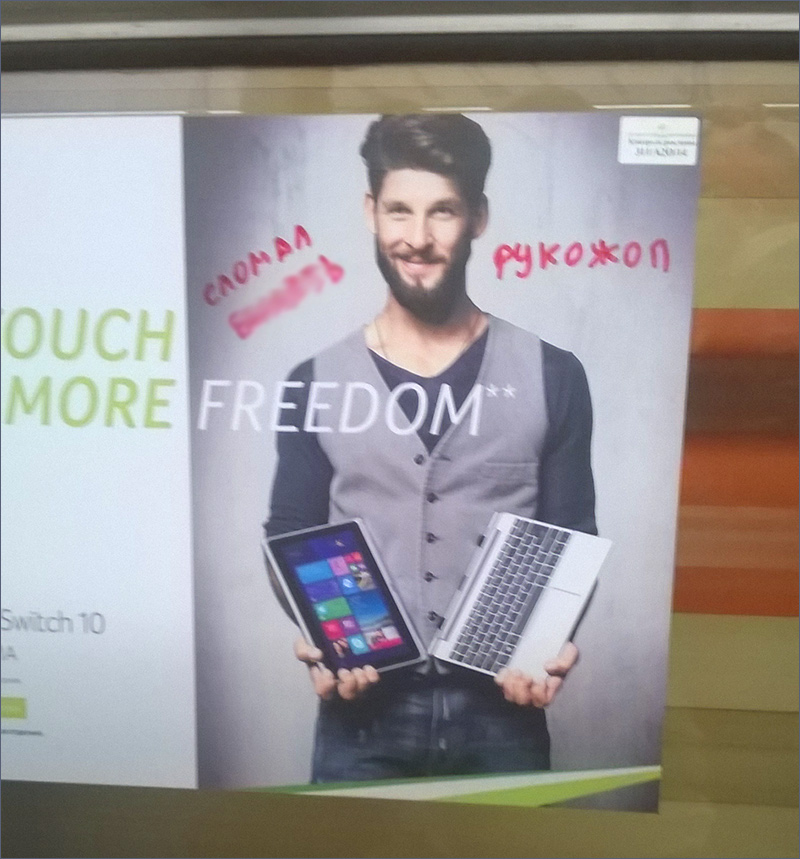

The process of gluing the two halves into a single unit helps to implement two magnets, but still it is not as easy as, for example, attaching SmartCover to the iPad. On the other hand, SmartCover and its keyboard counterparts and half the convenience of printing from this ASUS do not give.
Inside the tablet book is a regular Android 4.4.2 with a proprietary ZenUI interface: the authors of the firmware have not made a lot of changes, but they are quite necessary. Immediately after launching, you have several desktops - one of them is littered with widgets, the second is empty.
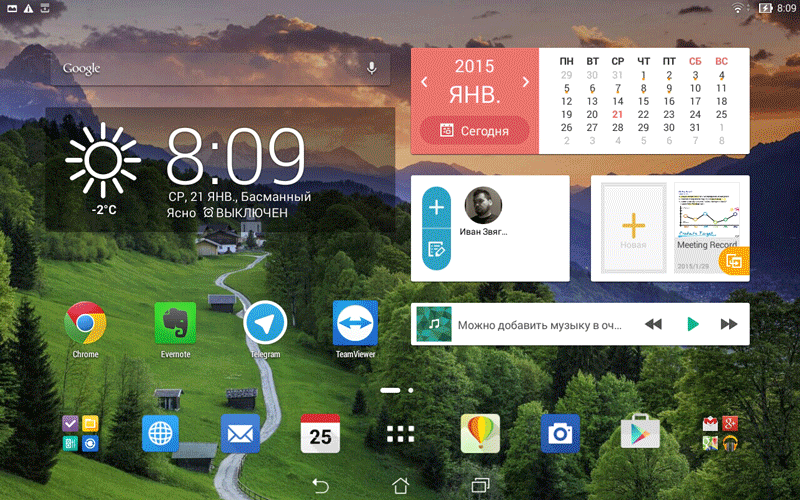
The color scheme is slowly shifting to that in Android 5.0. The quick access panel to the settings, by the way, is configured quite flexibly.
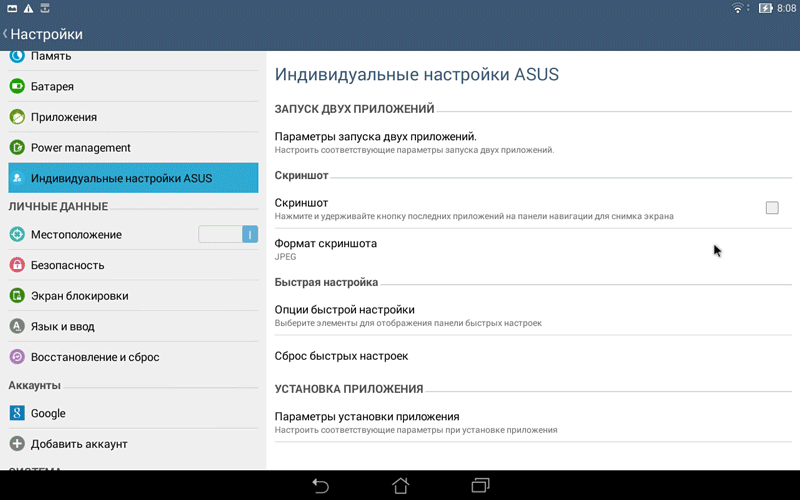
A convenient file manager is available from the box:

There are some good privacy settings: you can password protect any application or any folder on a disk or memory card. The rest is Android as Android.
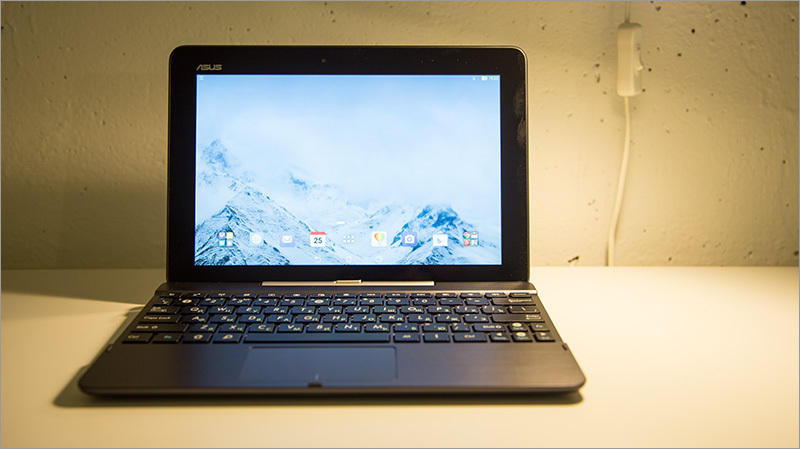
Iron tests, if anyone is interested, are hidden here:
Now the most burning question. How to live with it?
I repeat the phrase again: this is an android tablet with a keyboard, not a laptop with a detachable screen. When you pick up the screen, there is no dissonance, but when the device is assembled into a single unit, it is difficult to forget that this is not a laptop.
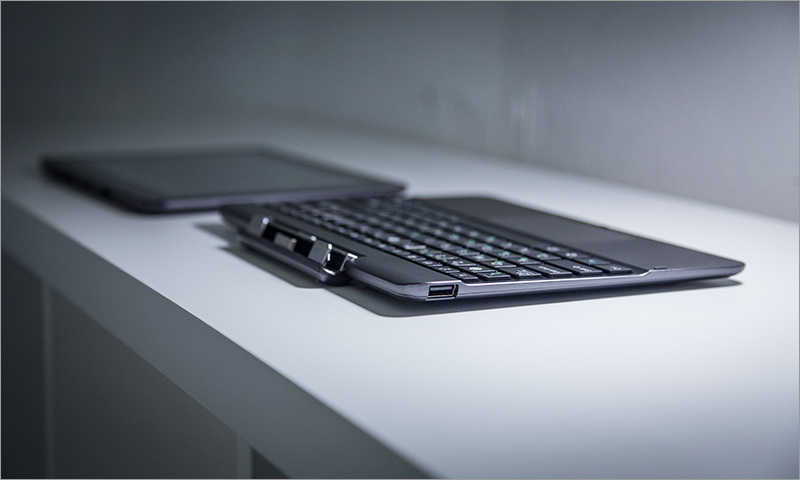
Well, for example, you make a screenshot - it seems to you that it appears on the desktop or on the clipboard, but it is not there. And the desktop, as such, is also, rather, a “start menu” on the whole screen. With widgets. You want to use multi-tasking, and the usual tray, dock, taskbar - either not, you have to get used to the hotkey or poke into the screen.

For internet surfing there is Google Chrome. In terms of performance and features, it does not lag behind the desktop, except that there are no developer tools, and no extensions. However, many of them are successfully replaced by regular Android applications and the interaction with them is provided by the Share button. Notes and clippings of the necessary information can be added to Evernote, in this regard, the process is no different from that on the desktop, phone or ipad, again, there are no problems with this.
To conduct lectures, write memoirs, memos and other office activities, you can use Google services and their semi-cloud Docs / Drive service: presentations, spreadsheets (and calculations), Office documents are opened and edited without problems. All documents will be copied to the "cloud", which guarantees their safety even if the device is broken or lost, and it is easy to organize collective access to such data.
If you need pixel-perfect mapping and perfect compatibility in editing MS Office documents, then Microsoft has not forgotten about you on Android: official tools are available for free .
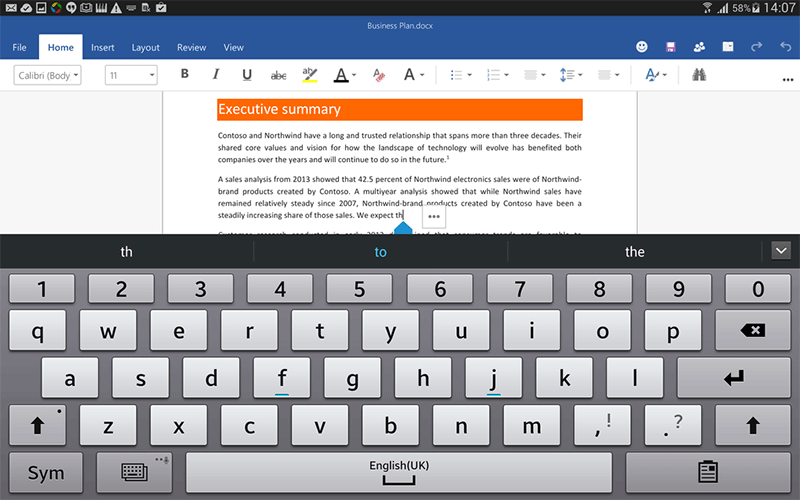
Screenshot politely borrowed on the Internet. :)
It is possible to draw a formula, a shemkit, or what kind of kozyavku either using the Google Keep service, which synchronizes notes with your desktop, or in other packages. For example, in any drawing. Then you can embed this image into your document.
With documents and their storage more or less sorted out.
Communicating in social networks, perhaps, will be even a little more convenient than on a PC: mobile applications are not inferior in capabilities to the site itself, but displaying information in the notification panel, a separate window reserved for communication, and no need for a constantly open tab is a plus.
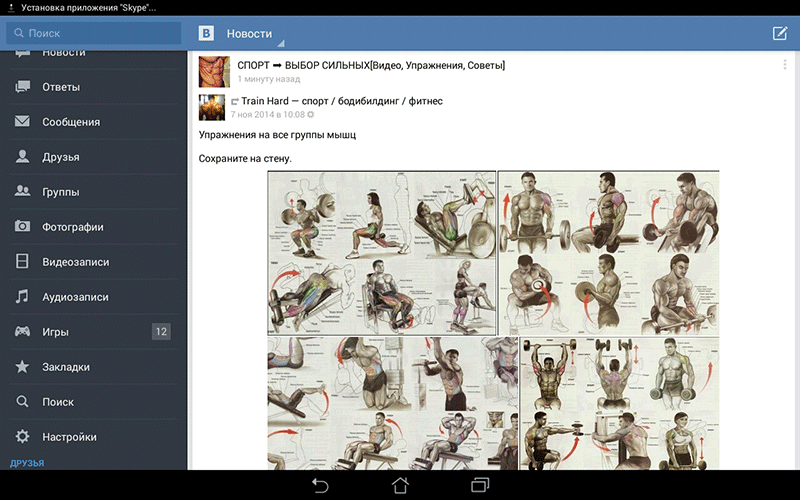
Skype client, of course, is somewhat poor, but tell me, where is it not poor? :)
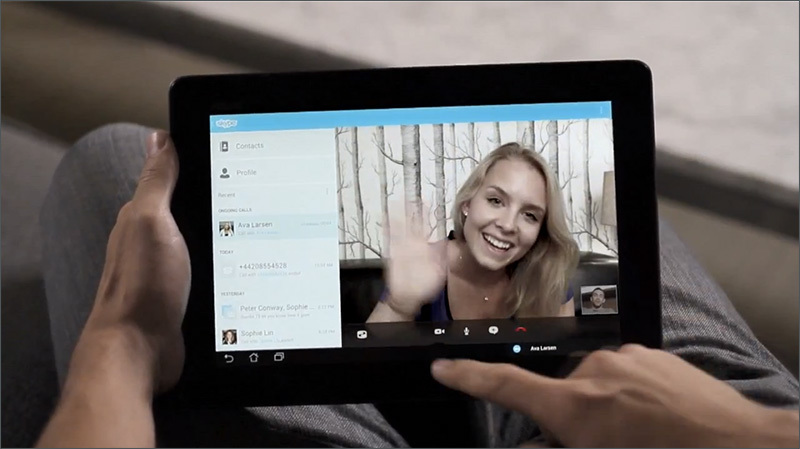
The tablet is not ours, we just placed the picture.
The undoubted advantage will be the ability to use typically “mobile” applications on the “laptop” - all sorts of Instagram, WhatsApp and other services that stubbornly ignore desktop operating systems and full-fledged Web versions of clients.
What else is required from a netbook?
With torrents cope any client from Google Play. With video playback - one of the many players. 70% of online services have either an application (like Ivi.ru), or are played directly in Chrome, without any problems. Adult content online is also played in a browser. O :)
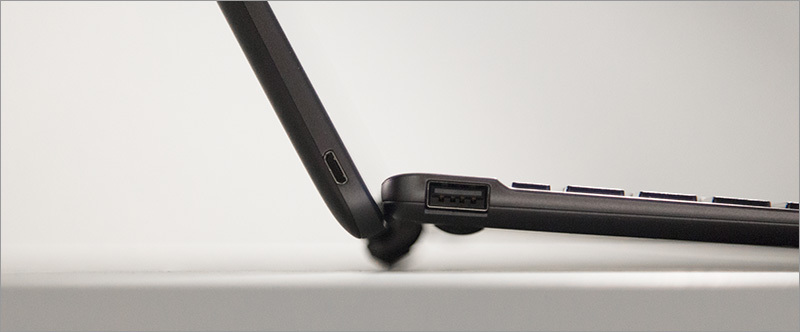
There is no problem with playing music either, the volume is not bad, at the maximum the speakers do not wheeze. Unfortunately, the laws of physics cannot be fooled, and there is not a lot to extract low frequencies from such a body, but they are excellent for communication through voice communication and watching movies.

There are a lot of games in the Play Store, the tablet easily detaches from the keyboard, after which you can safely throw birds into pigs, build towers, collect another 2048 or whatever they now have on their cell phones ...
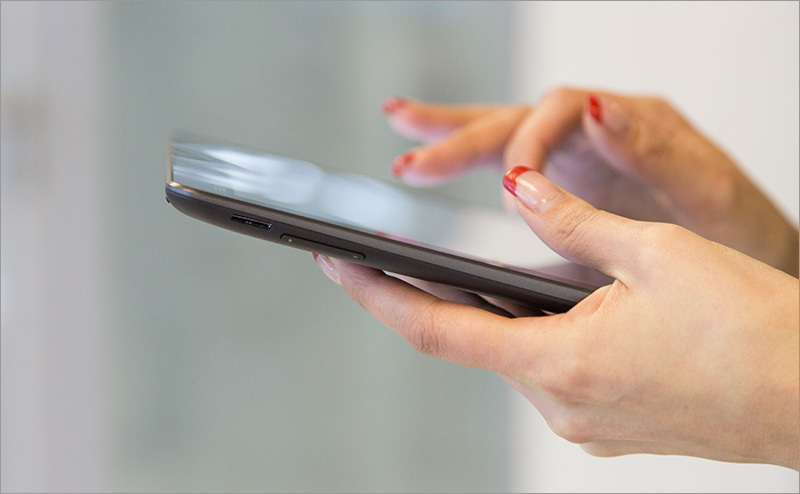
Let's move on to hard tasks. A photoshop on such a screen is a meaningless and merciless undertaking, but some AutoCAD or Matlab may well be needed, and not at home, where there is a normal computer, but “on the spot”. What to do? TeamViewer will come to the rescue. We connect to any available computer with installed software, do what we need, pick up files over the network. If there is no WiFi nearby - there is 3G, the modem is built into the laptop, the reception quality is excellent. Not to say that the conditions are gorgeous, but you can work.
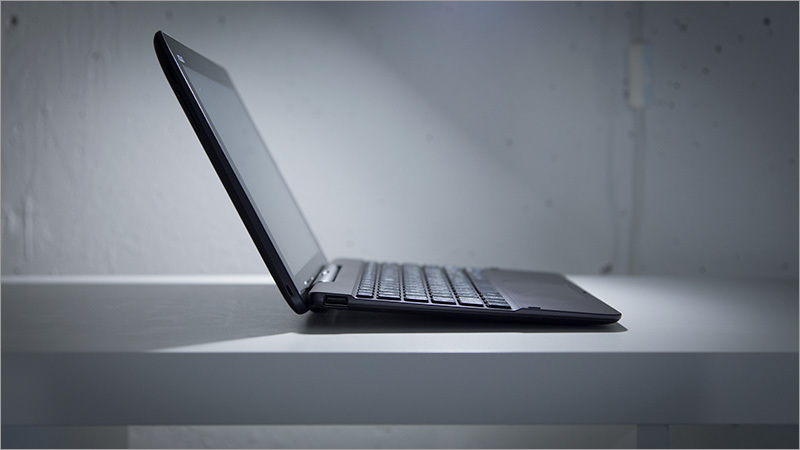
It turns out that everything that a simple user or student needs is there? But that is not all. Unlike a desktop, laptop, or any other device, such a tablet on Android has another serious advantage, especially for students and everyone involved. The mobile OS is perfectly integrated ... Calendar! Using the built-in scheduler (whether from Google or some other) is much more convenient than on a classic device. And taking into account the fact that reminders, the day plan, schedule, up-to-date information, prompts from the intelligent Google Now system and other delights of a truly integrated scheduler will regularly come out on the Lockscreen, in the notification panel and just on top of the screen - life will become much more convenient. Especially if you connect classmates to this business.
The tablet has two modules at once: it will not be possible to compete with Ken Rockwell , but they perform their purely utilitarian function. In Skype / Hangautse you can see the head and some features of the face - great. The rear camera shoots A4 sheet, the text can be disassembled without connecting psychics and artificial intelligence - excellent.
One of the most important questions for a netbook is how much it can handle without being connected to the network. With average use in the form of a typewriter with Internet access, the tablet-out will withstand 8 hours, maybe 9 uses. With active use, the autonomous navigation period, respectively, will be reduced. Games land a battery in 3-4 hours. There was no revolution in this regard, on the other hand, the price is more than modest, and a powerbank of some 3-4 thousand will extend the life of the device without problems, good, charging from a regular USB.

Can this be called the resurrection of netbooks as a class? On the one hand, yes. Affordable (i.e. inexpensive), easy-to-learn, compact device with good features and advanced networking capabilities + modern cloud technologies - this is cool. Here you will find Office, Internet, entertainment, and all this in a friendly environment of Android OS, with multitasking and convenient notification panel. The device copes with the main tasks of the netbook: it is convenient to go online, it is convenient to communicate, it works for a long time and is easy. Again, it charges even in the car from the classic MicroUSB, which is undoubtedly a plus - you do not need to buy an inverter and carry a bag of adapters.
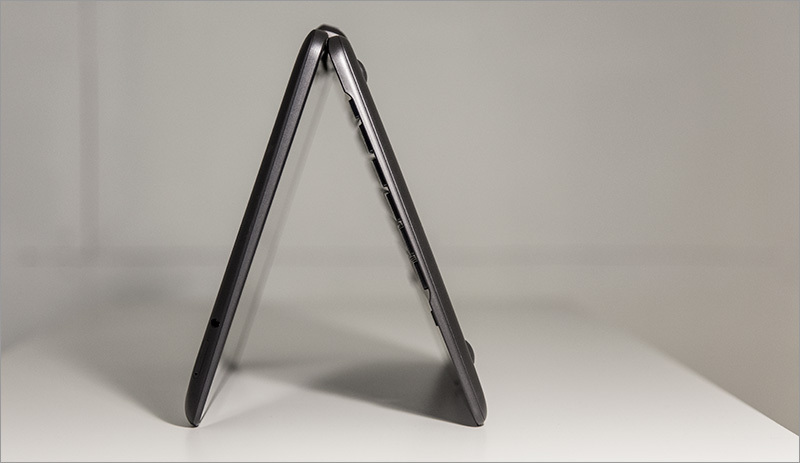
On the other hand, if on netbooks with a classic OS, you can solve desktop-level tasks without attracting other computers, in the case of Android you can only use a netbook as a remote access terminal for such software. In conditions of poor cellular network coverage and / or lack of WiFi, this is a scourge of this type of device. In the rest - well, just think, work through the remote. 2015 year in the yard, who will surprise with this?
Advantages and disadvantages:
+ Easy
+ Compact
+ Disconnects into two parts.
+ Well assembled
+ Works great
+ Easy to learn.
+ Charged by microUSB
+ Without ROOT, it is rather difficult to catch the malware, in which case the recovery and reset to the factory settings will fix everything, after which the system will restore all settings and applications from the cloud
+ Access to Android OS applications
+ Simple and nice shell ZenUI
+ The battery, nevertheless, is not bad, especially considering the cost of the device
- Desktop applications only via remote access
- 12-15-18 hours without recharging - only if the device is lying and idle :)
- Difficult to find accessories
- Keyboard without backlight
Now ASUS TF-103CG is sold in Yulmart at a price of 14,590 rubles for the version with 8 GB of memory and 3G of dark color and up to 16,990 for the light version with 16 gigs on board ... Not so much for a fairly convenient netbook, and more in our difficult, in terms of prices for electronics, time. In addition, you can always tear off the keyboard and use it as a tablet. :)
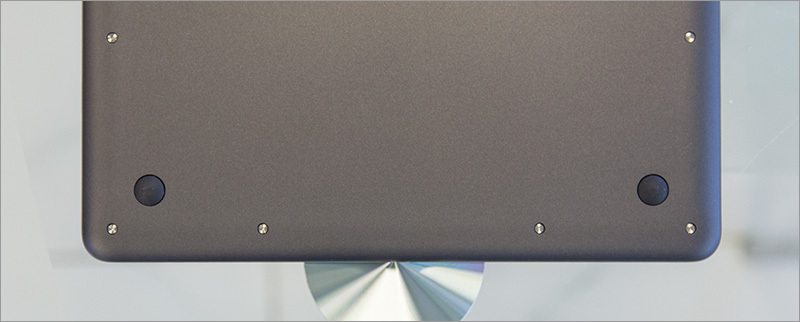
Such devices are unlikely to gain their former popularity, but they will find their niche for sure. Asus TF103CG is perfectly “sharpened” on the consumption of Internet content, ease of communication and development, it will be an excellent companion in work, study and recreation, if you clearly understand that it meets your needs. Well, if you, nevertheless, are accustomed to the "desktop" OS and you are ready to put up with less autonomy - at your service Asus T100A . The same weight, about the same characteristics, but Windows 8.1 on board.

Our previous reviews:
» Razer Kraken headsets
» Midland GXT-1050 Radio Stations
» NVIDIA SHIELD Game Console
» Testing AA-size Ni-MH batteries
» Sony Smartwatch 3
» Transformer Lenovo Yoga 2 Pro
» LEGO Mindstorms EV3

ASUS TF103CG is a hybrid tablet, netbook and just a cool device on the Android OS. Is it possible to fully live with such a set of properties?
I could not decide for a long time how to proceed with the beginning of the article: tell about the device and then try to understand for whom it is, or, conversely, first present a certain audience for it and then understand whether this device is suitable for this audience or not. I decided to take the second path, so let's start by defining the parameters of “fully live”. It would not be a question if you were on a Windows netbook, however, we are dealing with a completely “mobile” Android OS!
')

What are people doing on a laptop today, if they needed an inexpensive, long-playing, compact device? First of all, of course, student needs emerge in my head. The university already in 2009, all netbook owners successfully overtook the "manuscripts" in lectures, and the "calculators" in the laboratory. Word and Excel covered 90% of typing requirements and more or less complex calculations. In addition, to prepare for any exam and share lectures much easier when they are stored in digital form. This also includes the constant access to Wikipedia and other online services. A course programmer, of course, will not be easy to write on such a device, and it won't be possible to put all sorts of CAD on Android, but we will solve this question later.

Who else besides students may be interested in such a device? In my opinion, such a laptop may be of interest to those parents whose children met with computers before them. Learn online and social networking, sometimes Skype, receive photos by mail and send them yourself. This also includes receiving news and weather, numerous reminders, a notebook and simple games.
Well and the third audience, by itself, - geeks. Their needs can rarely be called “ordinary” or “popular”, and they will always find what to do with what OS the device doesn’t enter the market.
So, for a normal digital life with such a device you need:
- Be able to edit MS Office documents;
- Have a full access to the Internet;
- Have the ability to sometimes run specialized software: image editors, CAD-systems;
- Have a convenient access to the file system, the ability to send and receive any attachments via the Internet, trite to be able to throw files on a USB flash drive;
Ideally, the device should not generally differ in user experience from the usual desktop OSes, but this is an unattainable ideal. Let's go to the capabilities of the device? :)
Specifications ASUS TF300CG 3G
The following hardware will solve our problems today:
Processor: X86 compatible, Intel Atom Z2560, 2 cores at 1.6 GHz;
RAM: 1024 MB;
Built-in memory: 16 GB;
Display: 10.1 ", IPS with LED-backlit, resolution - 1280x800 pixels, touch, up to 10 touches;
Wireless interfaces: WiFi b / g / n, Bluetooth 4.0 LE, 2G / 3G cellular networks;
Sensors: GPS, three-axis gyroscope, three-axis accelerometer, light sensor;
Connectors: 3.5 mm MiniJack for connecting a headset, a microSD memory card, microUSB in a screen module, USB in a keyboard, a proprietary dock connector;
Camera: 2 Megapixel main, 0.3 Megapixel front.

The manufacturer claims the battery capacity of 19 watts * hours and up to 9.5 hours of battery life, weighs all this magnificence in the collection of 550 grams.
As you can see, the hardware device did not go far from its ideological parents, except that modern technologies allowed the device to significantly "squeeze", and to work longer with about the same loads.
Equipment
The box is made in the standard “Asusov” style, and looks more like a notebook than a tablet, but the package bundle is mobile.

Inside there is only the device itself, the adapter in the outlet (with a USB-mom) and a USB-cord (all kinds of papers do not count). No headphones, no bag, no cover, no cloth to wipe the screen. :(

It is already good that the device is charging through the most standard and ordinary microUSB, which is on every corner - you can not carry the charge with you.

On the other hand, from any telephone semi-amp network memory can be recharged all night: the native power supply produces 1.35 A.

Oh yes. There is also such a thing to extract the sim-tray.

Tablet and keyboard
The first thing you need to understand when communicating with this device is that this is an Android tablet with a keyboard, and not a laptop with a detachable display. Therefore, it is not entirely clear why the device is called a “transformer” - there are no transformation options as such, unlike the same yoga ; otherwise, with the same success, the transformer can be called any other tablet, to which you can buy an accessory in the form of a keyboard.

The tablet is made of plastic, the coating is somewhat like a soft-touch, but it is much less “rubber” - just a high-quality matte coating.

My copy was of a brown tint; light gray versions are also on sale. By itself, the body is not very easily soiled: it does not collect dirt, dust does not stick to it, but after the fried chicken the hands should be well washed - fat fingerprints remain, but it is not easy to scrub them.

I remember well how ASUS in each model of the netbook made frames around the displays, however, this time it carried by - apparently, only due to the fact that the touch screen is used. It is covered with a glossy protective glass with oleophobic coating, supports multitouch.

The resolution, of course, is not the flagship name (1280x800), but in work for many tasks it will be quite enough. Unsatisfied users will not see the difference, but I can advise those who are used to retinas and other HiPDI devices only to look at the price of the device: 16,490 ever-tree rubles (at the time of writing this article). The sensitivity of the sensor is good, the brightness margin is sufficient, it is regulated within very wide limits.

The keyboard module contains 81 buttons, a USB port for connecting external devices, a touchpad, and a proprietary connector to work with the tablet, and (probably) a cast-iron plate, otherwise the weight cannot be explained. :) Material - matte plastic with brushed aluminum texture, pleasant to the touch, but does not give a drop of iron chill.

Keystroke, their size is typically netbook, since 2008-2009 nothing has changed. Well, except that there is no F1-F12, as they are not needed in Android OS. Instead, the buttons for adjusting the brightness, volume, taking screenshots, and all that for which you would have to remove your hands from the keyboard. In general, not a MacBook, of course, but you can use it.

The keys have no backlighting, although with such a simple device, the dock might well have collapsed on the LEDs, there are no tricky electronics, there shouldn't have been any problems with installing the backlight.

The touchpad can be used, the cursor moves normally, to get to the letter-letter distance is not a problem, but in most cases it is easier to poke into the screen. The touchpad sound is quite loud, the button stroke is tight, but you can get used to it.

Transformation from one state to another is easier than ever: squeezed the “clutch pedal”, and tore off the screen. Like that:


The process of gluing the two halves into a single unit helps to implement two magnets, but still it is not as easy as, for example, attaching SmartCover to the iPad. On the other hand, SmartCover and its keyboard counterparts and half the convenience of printing from this ASUS do not give.
Work with the device
Inside the tablet book is a regular Android 4.4.2 with a proprietary ZenUI interface: the authors of the firmware have not made a lot of changes, but they are quite necessary. Immediately after launching, you have several desktops - one of them is littered with widgets, the second is empty.

The color scheme is slowly shifting to that in Android 5.0. The quick access panel to the settings, by the way, is configured quite flexibly.

A convenient file manager is available from the box:

There are some good privacy settings: you can password protect any application or any folder on a disk or memory card. The rest is Android as Android.

Iron tests, if anyone is interested, are hidden here:
Performance tests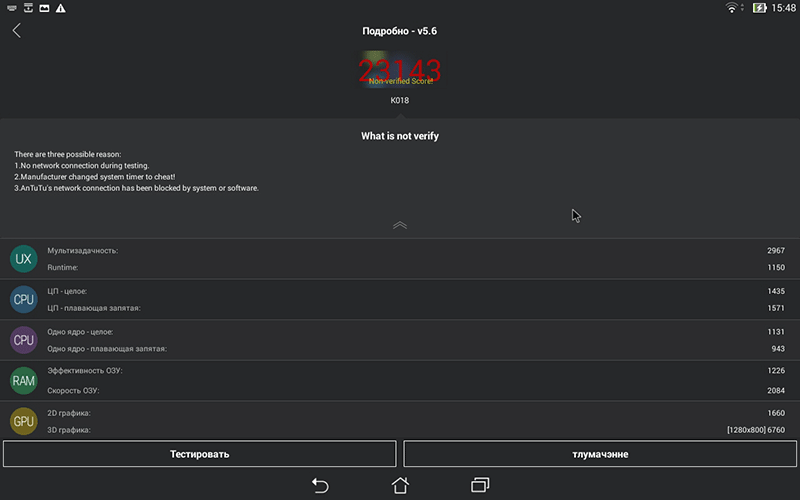
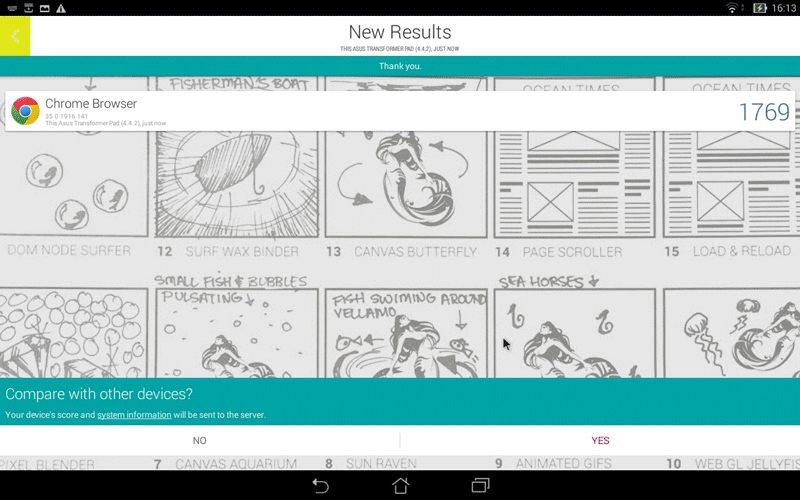
Rather modest results in synthetic tests can be attributed to a not very “familiar” OS architecture: nevertheless, x86 processors in Android devices are much less common than ARM, and the test suite in benchmark programs cannot show actual processor performance. In real life, the capabilities of the Intel Atom Z2560 are enough for all the tasks that you can put on a tablet, except that it is unlikely that you will be able to mine the bitcoins on it, and even doing this on such capacities is completely meaningless.


Rather modest results in synthetic tests can be attributed to a not very “familiar” OS architecture: nevertheless, x86 processors in Android devices are much less common than ARM, and the test suite in benchmark programs cannot show actual processor performance. In real life, the capabilities of the Intel Atom Z2560 are enough for all the tasks that you can put on a tablet, except that it is unlikely that you will be able to mine the bitcoins on it, and even doing this on such capacities is completely meaningless.
Now the most burning question. How to live with it?
I repeat the phrase again: this is an android tablet with a keyboard, not a laptop with a detachable screen. When you pick up the screen, there is no dissonance, but when the device is assembled into a single unit, it is difficult to forget that this is not a laptop.

Well, for example, you make a screenshot - it seems to you that it appears on the desktop or on the clipboard, but it is not there. And the desktop, as such, is also, rather, a “start menu” on the whole screen. With widgets. You want to use multi-tasking, and the usual tray, dock, taskbar - either not, you have to get used to the hotkey or poke into the screen.

For internet surfing there is Google Chrome. In terms of performance and features, it does not lag behind the desktop, except that there are no developer tools, and no extensions. However, many of them are successfully replaced by regular Android applications and the interaction with them is provided by the Share button. Notes and clippings of the necessary information can be added to Evernote, in this regard, the process is no different from that on the desktop, phone or ipad, again, there are no problems with this.
To conduct lectures, write memoirs, memos and other office activities, you can use Google services and their semi-cloud Docs / Drive service: presentations, spreadsheets (and calculations), Office documents are opened and edited without problems. All documents will be copied to the "cloud", which guarantees their safety even if the device is broken or lost, and it is easy to organize collective access to such data.
If you need pixel-perfect mapping and perfect compatibility in editing MS Office documents, then Microsoft has not forgotten about you on Android: official tools are available for free .

Screenshot politely borrowed on the Internet. :)
It is possible to draw a formula, a shemkit, or what kind of kozyavku either using the Google Keep service, which synchronizes notes with your desktop, or in other packages. For example, in any drawing. Then you can embed this image into your document.
With documents and their storage more or less sorted out.
Communicating in social networks, perhaps, will be even a little more convenient than on a PC: mobile applications are not inferior in capabilities to the site itself, but displaying information in the notification panel, a separate window reserved for communication, and no need for a constantly open tab is a plus.

Skype client, of course, is somewhat poor, but tell me, where is it not poor? :)

The tablet is not ours, we just placed the picture.
The undoubted advantage will be the ability to use typically “mobile” applications on the “laptop” - all sorts of Instagram, WhatsApp and other services that stubbornly ignore desktop operating systems and full-fledged Web versions of clients.
What else is required from a netbook?
With torrents cope any client from Google Play. With video playback - one of the many players. 70% of online services have either an application (like Ivi.ru), or are played directly in Chrome, without any problems. Adult content online is also played in a browser. O :)

There is no problem with playing music either, the volume is not bad, at the maximum the speakers do not wheeze. Unfortunately, the laws of physics cannot be fooled, and there is not a lot to extract low frequencies from such a body, but they are excellent for communication through voice communication and watching movies.

There are a lot of games in the Play Store, the tablet easily detaches from the keyboard, after which you can safely throw birds into pigs, build towers, collect another 2048 or whatever they now have on their cell phones ...

Let's move on to hard tasks. A photoshop on such a screen is a meaningless and merciless undertaking, but some AutoCAD or Matlab may well be needed, and not at home, where there is a normal computer, but “on the spot”. What to do? TeamViewer will come to the rescue. We connect to any available computer with installed software, do what we need, pick up files over the network. If there is no WiFi nearby - there is 3G, the modem is built into the laptop, the reception quality is excellent. Not to say that the conditions are gorgeous, but you can work.

It turns out that everything that a simple user or student needs is there? But that is not all. Unlike a desktop, laptop, or any other device, such a tablet on Android has another serious advantage, especially for students and everyone involved. The mobile OS is perfectly integrated ... Calendar! Using the built-in scheduler (whether from Google or some other) is much more convenient than on a classic device. And taking into account the fact that reminders, the day plan, schedule, up-to-date information, prompts from the intelligent Google Now system and other delights of a truly integrated scheduler will regularly come out on the Lockscreen, in the notification panel and just on top of the screen - life will become much more convenient. Especially if you connect classmates to this business.
Camera
The tablet has two modules at once: it will not be possible to compete with Ken Rockwell , but they perform their purely utilitarian function. In Skype / Hangautse you can see the head and some features of the face - great. The rear camera shoots A4 sheet, the text can be disassembled without connecting psychics and artificial intelligence - excellent.
Autonomy
One of the most important questions for a netbook is how much it can handle without being connected to the network. With average use in the form of a typewriter with Internet access, the tablet-out will withstand 8 hours, maybe 9 uses. With active use, the autonomous navigation period, respectively, will be reduced. Games land a battery in 3-4 hours. There was no revolution in this regard, on the other hand, the price is more than modest, and a powerbank of some 3-4 thousand will extend the life of the device without problems, good, charging from a regular USB.

Summing up
Can this be called the resurrection of netbooks as a class? On the one hand, yes. Affordable (i.e. inexpensive), easy-to-learn, compact device with good features and advanced networking capabilities + modern cloud technologies - this is cool. Here you will find Office, Internet, entertainment, and all this in a friendly environment of Android OS, with multitasking and convenient notification panel. The device copes with the main tasks of the netbook: it is convenient to go online, it is convenient to communicate, it works for a long time and is easy. Again, it charges even in the car from the classic MicroUSB, which is undoubtedly a plus - you do not need to buy an inverter and carry a bag of adapters.

On the other hand, if on netbooks with a classic OS, you can solve desktop-level tasks without attracting other computers, in the case of Android you can only use a netbook as a remote access terminal for such software. In conditions of poor cellular network coverage and / or lack of WiFi, this is a scourge of this type of device. In the rest - well, just think, work through the remote. 2015 year in the yard, who will surprise with this?
Advantages and disadvantages:
+ Easy
+ Compact
+ Disconnects into two parts.
+ Well assembled
+ Works great
+ Easy to learn.
+ Charged by microUSB
+ Without ROOT, it is rather difficult to catch the malware, in which case the recovery and reset to the factory settings will fix everything, after which the system will restore all settings and applications from the cloud
+ Access to Android OS applications
+ Simple and nice shell ZenUI
+ The battery, nevertheless, is not bad, especially considering the cost of the device
- Desktop applications only via remote access
- 12-15-18 hours without recharging - only if the device is lying and idle :)
- Difficult to find accessories
- Keyboard without backlight
Now ASUS TF-103CG is sold in Yulmart at a price of 14,590 rubles for the version with 8 GB of memory and 3G of dark color and up to 16,990 for the light version with 16 gigs on board ... Not so much for a fairly convenient netbook, and more in our difficult, in terms of prices for electronics, time. In addition, you can always tear off the keyboard and use it as a tablet. :)

Such devices are unlikely to gain their former popularity, but they will find their niche for sure. Asus TF103CG is perfectly “sharpened” on the consumption of Internet content, ease of communication and development, it will be an excellent companion in work, study and recreation, if you clearly understand that it meets your needs. Well, if you, nevertheless, are accustomed to the "desktop" OS and you are ready to put up with less autonomy - at your service Asus T100A . The same weight, about the same characteristics, but Windows 8.1 on board.

Our previous reviews:
» Razer Kraken headsets
» Midland GXT-1050 Radio Stations
» NVIDIA SHIELD Game Console
» Testing AA-size Ni-MH batteries
» Sony Smartwatch 3
» Transformer Lenovo Yoga 2 Pro
» LEGO Mindstorms EV3
Source: https://habr.com/ru/post/376065/
All Articles